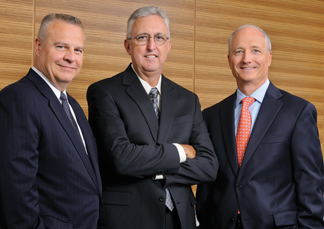Growth Strategy
Kaman Industrial Technologies expands its technology platform through acquisitions
By Rich Vurva
 |
|
Left to right: Philip Goodrich, Kaman senior vice president of corporate development, Steve Smidler, KIT president, and Neal Keating, Kaman Corp. chairman, president and CEO have a successful track record of acquiring distributors. |
With a growth rate averaging 15 percent a year, Kaman Industrial Technologies is on target to reach its goal of about $1.5 billion in sales by 2014. Over the past two years, the increased sales have been fairly evenly divided between organic growth and sales volume added through acquisitions. But with softening industrial demand, a greater percentage of the company’s growth this year and next may depend on the company’s ability to acquire independent distributors.
That objective will be aided by a strong balance sheet and a successful track record of making acquisitions. Since 2008, the nation’s third largest distributor in the power transmission/motion control market has completed 11 acquisitions. Its recent purchase of Florida Bearings Inc. in Miami strengthened the company’s presence in southern and central Florida, while its acquisition of Zeller Corp., expands Kaman’s electrical, automation and motion control product portfolio to include electrical controls and power distribution.
Currently operating in 74 of the top 100 industrial markets in the United States, Kaman has its sights set on growing its geographic footprint to enhance its position
with national accounts.
“We’re looking for well-run businesses with good management teams that are recognized in the markets that they serve as delivering value to the customers and providing high levels of customer service,” says Neal Keating, chairman, president and CEO of Kaman Corporation.
Kaman does not disclose the purchase price of individual acquisitions. However, in presentations to financial analysts, the company says it spent about $130 million, or an average of $14 million, on nine acquisitions completed between 2008 and 2011. The average size of the acquired companies was $30 million, with total acquired sales for that time frame of $275 million.
The acquisition strategy has enabled Kaman to expand its technology platform beyond traditional bearings and mechanical power transmission products. The 2010 acquisition of California-based Minarik Corporation provided a foothold in the motion control and automation category. The subsequent 2011 acquisitions of Automation Technology in the Pacific Northwest, and Target Electronic Supply and Zeller Corp. in the Northeast further enhanced its capabilities in the electrical, automation and motion control category, which now represents about 16% of the company’s total sales.
Late in 2011, the purchase of Catching Fluidpower in Chicago provided Kaman with expertise in the fluid power category, which today accounts for about 12% of sales. That acquisition also opened the door for signing a national value-added reseller agreement with Parker Hannifin. Under the agreement, Kaman’s nearly 200 nationwide customer service centers have full access to the Parker motion technologies portfolio of products across all of its U.S. locations utilizing Parker’s Integrated Partners.
For the time being, Kaman is maintaining the brand names of the acquired companies. That decision was driven in part by relationships with motion control and fluid power suppliers that have authorized distribution agreements with Minarik, Zeller or Catching, for
example, but not with Kaman.
Although each subsidiary falls under the Kaman umbrella, they maintain separate, unique sales forces with expertise in their technology platform.
“We have highly trained sales specialists in each of our three technology platforms,” explains Keating. “Whether it’s electrical, automation and control with Minarik or Zeller, fluid power with Catching, or in our legacy KIT locations, we want to have that knowledge, experience and focus. At the same time, we want to be able to leverage those technologies and product lines across the customer base.”
 Maintaining continuity
Maintaining continuity
“Wherever possible, we like to keep the full management team on board and actively engaged as part of our management team, including the owners,” says Keating. “There are so many things they can do for us from a legacy customer perspective, from a supplier perspective and in the area of employee advocacy.”
Steven Smidler, president of Kaman Industrial Technologies, adds that
former owners typically sign contracts to stay involved through the integration process for one to two years.
The company has an established integration team that oversees the integration process, such as transitioning the acquired companies onto Kaman’s technology system and explaining HR, payroll and benefits policies to employees.
“We always pull in team members from the acquired company onto
the integration team because you need that level of internal advocacy,” says Smidler.
Continuing involvement from former owners and other key management people helps alleviate the anxiety that employees typically feel when their employer is acquired by a much larger entity. They’re not only becoming accustomed to a new reporting structure and an unfamiliar benefits policy, in many cases they’re concerned about the future of their job.
“These owners look at their employees as an extension of their family,” says Keating.
Knowing that a high percentage of employees likely will remain with the company after the acquisition, and the improved insurance and other benefits that come from being part of a large company, helped owners like Richard Guminski of Catching Fluidpower decide to sell his company to Kaman.
Guminski acknowledges that he might have achieved a higher price by selling to a private equity group, but he was more interested in doing business with a company that understands the distribution industry.
“I’m the kind of guy who really believes in my employees and I wanted what was best for them. I wanted to sell to someone who knew the distribution business; they weren’t
in it just to strip the company for more profits,” he says.
One long-time Catching employee whose husband started a new job in Atlanta was able to transfer to a Kaman location in Atlanta without losing seniority or benefits. “That
kind of thing would never have happened before. This has created new opportunities for my employees,” Guminski says.
The company is careful not to take an aggressive cost-cutting approach following an acquisition. The objective is to increase value by introducing new product and service offerings, not to reduce overhead by eliminating jobs and consolidating offices. Efficiencies of scale produces benefits – such as better discounts with UPS and other shippers, and increased buying power with suppliers – but the primary benefits gained following an acquisition come from growing sales, not lowering costs.
“The owners of businesses who have sold to Kaman are really our best advocates in the market place, describing to other owners what the process has entailed for them, how well we’ve treated their employees, and how the customers have been happy with the transition,” says Philip Goodrich, senior vice president of corporate development.
Managing supplier expectations was a bigger issue than handling concerns of employees or customers, according to Bill Cooney, president of Target Electronics. “We were fortunate to have very long relationships with some suppliers. In return they got a big share of our mindset.
A major concern of theirs going forward was, ‘Will we still have that close relationship? Will we still be your primary line?’” he says.
Cooney adds that relationships with key suppliers have not changed, and customers have responded favorably to the change because there have been no personnel changes. “One of our charters is to grow the business, so we have been going in to Kaman customers where we didn’t do business and talking about our products and bringing the Kaman salespeople into our accounts where they didn’t do business before. The benefit to the customer is that they have access to more products from a vendor that they know and trust,” Cooney says.
Cooney considered selling his business to other potential buyers but decided that Kaman had the best track record of successfully acquiring and integrating companies. “They’ve been down this road before and know what they’re doing,” he says. Like Guminski, Cooney wanted to deal with a buyer that could offer the best career opportunities for his employees, many of whom had been with him for several years.
His advice to other owners considering the sale of their company is to look at the buyer’s history of acquisitions before making a final decision.
Kaman executives are hopeful that other distribution company owners will come to the same conclusion as Cooney. If the right owners are interested in selling, Kaman Industrial Technologies is prepared to buy.
“We’ve got a strong balance sheet so we’re not limited from a financial capacity to continue the pace of doing deals. And we’ve got a good culture and a strong infrastructure
to be able to handle additional acquisitions,” Smidler says.
This article originally appeared in the Sept./Oct. 2012 issue of Industrial Supply magazine. Copyright 2012, Direct Business Media.












